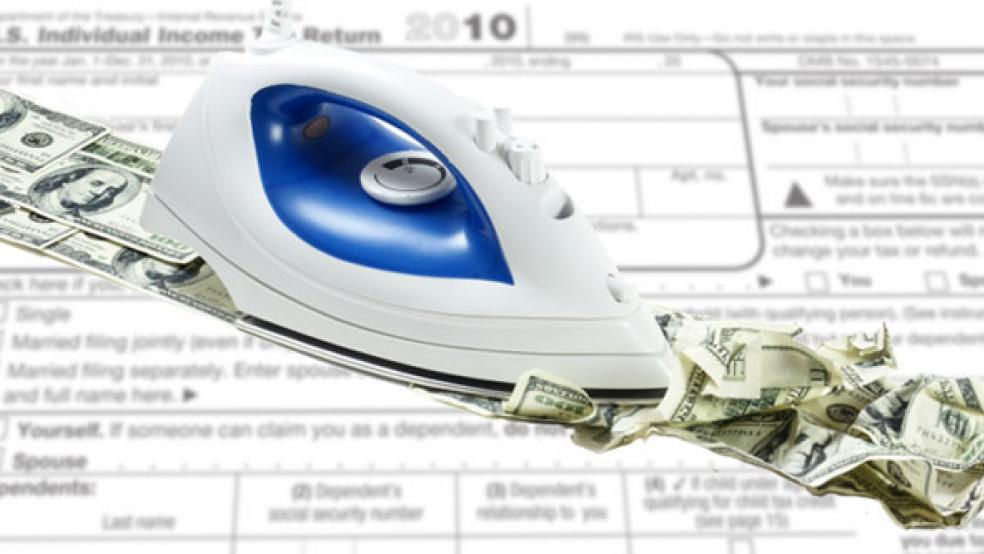Further evidence that the prospects for tax reform are diminishing is that silly, gimmicky tax reform ideas are resurfacing. These are not serious proposals, but ideas designed to mislead people into thinking there is a magic bullet that will fix every tax problem without making anyone worse off.

The original magic bullet was the flat tax. Its main attraction was not so much a single rate as the idea that everyone could file their taxes on a postcard-sized form. This was always a meaningless attraction for most people since the 1040EZ form that they use now is only one page.
Moreover, the simplicity of the flat tax form disguised the fact that very fundamental changes in tax policy would have to be implemented to achieve it. All deductions, including those for mortgage interest and charitable contributions, would be abolished, and there would be no taxation whatsoever on interest, dividends or capital gains, which would almost exclusively benefit the ultra-wealthy. All fringe benefits such as health insurance would be taxed.
Furthermore, even if one agreed with the ultimate goal of having a single-rate tax system on a consumption base that would raise taxes for most Americans while massively cutting them for the ultra-wealthy, getting from here to there is practically impossible. For example, homeowners would suffer a 15 percent reduction in the value of their homes from withdrawal of the mortgage interest deduction even if they themselves paid no more taxes in total than they do now.
In short, the simplicity of the flat tax was purely superficial; the postcard return meant little and having a single tax rate contributes little to simplicity because the rate structure has little to do with tax complexity, which mainly relates to the tax base. Even if it were allowed to operate as intended – a political impossibility – the transition from our current system to the flat tax would be massively complex.
One way conservatives thought they could overcome the complexity of transitioning from the current system to the flat tax was to have two tax systems – the current system and an alternative flat tax system. People could simply choose which system they preferred.
The stupidity of this idea really defies my ability to explain it, but I will try.
First, having two tax systems would obviously add massively to the complexity of the tax system, which anyone familiar with the existing alternative minimum tax knows. Many taxpayers would have to do their taxes twice to see which way they would come out ahead.
Second, it was never clear whether people could switch back and forth from one system or the other, or whether the old system would sunset at some date certain. Some advocates suggested that once a taxpayer chose the new system they could never go back. But what happens when two people marry and one is in the alternative system and her spouse is in the other? A couple could easily arrange to have one member earn all the joint income while the other got all the deductions.
Third, it’s obvious that the only people who would choose the alternative system would be those who saved taxes as a consequence. Therefore, having an alternative flat tax would be a massive tax cut in the aggregate. When former Senator Fred Thompson proposed this idea in 2007, the Tax Policy Center estimated that it would reduce federal revenues by about $7 trillion over 10 years.
Fourth, advocates of an alternative flat tax system have never, to my knowledge, made the slightest effort to construct such a system that would be revenue neutral. They just blithely pull tax rates out of the air and assert that somehow or other it will work. Just this week, the economist John Cochrane of the University of Chicago business school, who should know better, did exactly that on the right-wing Wall Street Journal editorial page, which has promoted the idea since the 1990s.
Finally, the original flat tax only worked in theory because the individual and business sides of the tax system were fully integrated. This was essential to its operation. It would have been impossible to only allow individuals to have the benefits of a flat rate system unless all of its provisions relating to business taxation and the taxation of capital were implemented simultaneously.
Yet alternative tax system advocates such as Prof. Cochrane propose to do exactly that – cherry pick the popular parts of the flat tax and jettison the rest. The result would be an unadministrable mess that slashed taxes for the ultra-wealthy, caused the deficit to explode and vastly increased tax complexity. Some reform.
Yet this isn’t even the silliest tax reform conservative have proposed. For many years, those in Congress pushed the idea of just abolishing the income tax altogether and replacing it with nothing. The idea was to create an event that would force Congress to enact a top-to-bottom tax reform.
Obviously, this would make tax planning impossible and would probably bring all business investment to a full stop. How could a company make any investment without knowing how things like depreciation, the deductibility of interest or the taxation of dividends will be treated in the future? The whole idea was so insane that it was impossible to take seriously, yet many Republicans did.
Tax gimmicks and stupid ideas that are obviously unworkable are not going to fix the tax system. There is no magic bullet for real reform. It’s dirty, ugly, World War I-style trench warfare against special interests that are deeply entrenched. People should not take seriously anyone who implies that tax reform is quick and easy.






